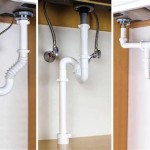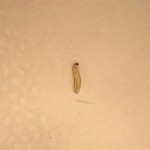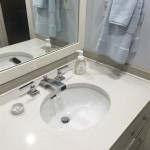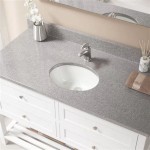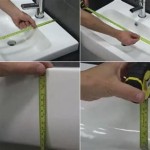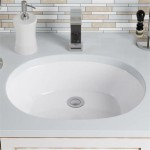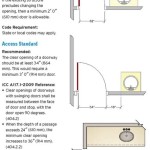I Have Little Black Bugs In My Bathroom: Identification, Causes, and Solutions
The discovery of small black bugs in the bathroom can be a disconcerting experience for homeowners. These tiny invaders can appear suddenly, often congregating around sinks, drains, and other damp areas. Identifying the specific type of bug is crucial for determining the source of the infestation and implementing effective control measures. This article provides a comprehensive overview of common bathroom bugs, their causes, and strategies for their elimination and prevention.
Common Culprits: Identifying the Little Black Bugs
Several species of small black bugs are frequently found in bathrooms. Accurate identification is the first step in devising an effective pest control strategy. The most common types include drain flies, fruit flies, and certain species of beetles.
Drain Flies (Psychodidae): Also known as moth flies or sewage flies, drain flies are small, fuzzy insects, typically dark gray to black in color. They are characterized by their rounded wings, which are covered in tiny hairs, giving them a moth-like appearance. Drain flies are weak fliers and often seen resting on walls or fixtures in the bathroom. Their larvae develop in stagnant water and organic matter buildup in drains, sewers, and septic tanks. The presence of drain flies indicates a significant buildup of slime and organic waste within the plumbing system.
Fruit Flies (Drosophilidae): Although commonly associated with overripe fruit in the kitchen, fruit flies can also thrive in bathrooms, particularly if there are sources of decaying organic material. These small flies are typically reddish-brown to dark brown in color and have red eyes. They are attracted to fermenting substances and can reproduce rapidly in moist environments. In bathrooms, they may breed in damp mop heads, clogged drains with organic debris, or even residue left in shampoo bottles or soap dishes.
Carpet Beetles (Dermestidae): While primarily known for damaging carpets and fabrics, certain species of carpet beetles can find their way into bathrooms. These small, oval-shaped beetles range in color from black to mottled brown. They feed on natural fibers, including shed skin cells, hair, and dead insects. Bathroom environments, particularly those with poor ventilation and accumulated dust, can provide suitable breeding grounds for carpet beetles. Their larvae, often referred to as "woolly bears," are covered in bristles and can cause skin irritation in some individuals.
Springtails (Collembola): These tiny, wingless insects are often mistaken for bugs due to their small size and ability to jump. They are typically dark gray or black and thrive in moist environments. Springtails feed on mold, fungi, and decaying organic matter. They are commonly found in bathrooms, especially in areas with high humidity and poor ventilation, such as around leaky pipes, damp walls, and potted plants.
Silverfish (Lepisma saccharina): While technically not a bug, silverfish are often grouped with bathroom pests due to their frequent presence in damp environments. These wingless insects are silver or gray in color and have a flattened, carrot-shaped body. Silverfish feed on starches, sugars, and cellulose, making them attracted to paper products, glue, and fabrics. In bathrooms, they may be found near books, magazines, or damp cardboard boxes.
Understanding the Causes of Bathroom Bug Infestations
Several factors contribute to bathroom bug infestations. Understanding these causes is essential for implementing preventive measures and addressing the root of the problem.
Moisture and Humidity: Bathrooms are inherently moist environments due to showering, bathing, and leaky plumbing. Insects are attracted to moisture for hydration and reproduction. High humidity levels create ideal conditions for the growth of mold and fungi, which serve as food sources for many bathroom pests, such as springtails and silverfish. Leaky pipes, dripping faucets, and inadequate ventilation exacerbate moisture problems and increase the likelihood of infestations.
Organic Matter Buildup: Organic matter, such as hair, soap scum, and dead skin cells, accumulates in drains, sinks, and other areas of the bathroom. This organic debris provides a breeding ground and food source for various pests, including drain flies, fruit flies, and carpet beetles. Clogged drains and pipes trap moisture and organic material, creating an ideal environment for insect larvae to develop. Inadequate cleaning practices and infrequent drain maintenance contribute to the buildup of organic matter and increase the risk of infestations.
Poor Ventilation: Inadequate ventilation allows moisture to persist in the bathroom, creating a humid environment that attracts pests. Lack of proper ventilation can lead to the growth of mold and mildew, which serve as food sources for insects like springtails and silverfish. Bathrooms without exhaust fans or with poorly functioning fans are particularly susceptible to pest infestations. Proper ventilation helps to reduce humidity levels and prevent the growth of mold and mildew, thereby deterring pests from entering the bathroom.
Access Points: Cracks and crevices in walls, floors, and around pipes provide entry points for insects to access the bathroom. These entry points can be difficult to detect and may allow pests to enter unnoticed. Gaps around windows and doors also provide access for insects, particularly during warmer months. Sealing these cracks and crevices can help to prevent pests from entering the bathroom and establishing infestations. Additionally, inspecting and repairing damaged screens can prevent flying insects from entering the home.
Existing Infestations: Sometimes, the bugs observed in the bathroom are not originating from within the bathroom itself. They may be spreading from an existing infestation in another part of the house. For example, a carpet beetle infestation in a bedroom could spread to the bathroom, particularly if there is a shared wall or adjacent carpeted area. Similarly, fruit flies from the kitchen may be attracted to the moisture and potential food sources in the bathroom.
Effective Strategies for Elimination and Prevention
Eradicating bathroom bug infestations requires a multi-pronged approach that addresses both the immediate problem and the underlying causes. Implementing effective cleaning, maintenance, and preventive measures is crucial for long-term pest control.
Thorough Cleaning: Regular and thorough cleaning is essential for removing food sources and breeding grounds for bathroom pests. This includes cleaning sinks, toilets, and shower areas to remove soap scum, hair, and other organic debris. Pay particular attention to cleaning drains with enzymatic drain cleaners that break down organic matter. Clean and disinfect mop heads regularly to prevent the growth of mold and bacteria. Vacuum bathroom floors and rugs frequently to remove dust, hair, and dead insects. Empty trash cans regularly and ensure that they are tightly sealed.
Drain Maintenance: Maintaining clean and clear drains is crucial for preventing drain fly infestations. Pour boiling water down drains regularly to flush out organic matter. Use a drain snake or brush to remove hair and debris from drainpipes. Consider using enzymatic drain cleaners on a regular basis to break down organic buildup and prevent clogs. Avoid pouring grease or oil down drains, as these substances can solidify and create breeding grounds for pests. Regularly inspect drainpipes for leaks and repair them promptly to prevent moisture buildup.
Moisture Control: Controlling moisture levels in the bathroom is essential for preventing infestations. Ensure proper ventilation by using exhaust fans during and after showers and baths. Repair leaky pipes and faucets promptly to eliminate water sources. Wipe down shower walls and floors after use to remove excess moisture. Consider using a dehumidifier in bathrooms with persistent humidity problems. Ensure adequate airflow in the bathroom by opening windows when possible. Avoid leaving damp towels or clothing lying around, as they can provide breeding grounds for mold and pests.
Sealing Entry Points: Sealing cracks and crevices in walls, floors, and around pipes can prevent pests from entering the bathroom. Use caulk to seal gaps around sinks, toilets, and bathtubs. Install weather stripping around windows and doors to prevent insects from entering. Inspect and repair damaged screens to keep flying insects out. Consider using expanding foam to fill larger cracks and crevices in walls. Regularly inspect the bathroom for new cracks and crevices and seal them promptly.
Professional Pest Control: In severe or persistent infestations, professional pest control services may be necessary. Pest control professionals have the knowledge and experience to identify the specific type of pest and implement targeted treatment strategies. They can also provide recommendations for preventing future infestations. When selecting a pest control company, ensure that they are licensed and insured. Discuss the treatment plan with the pest control professional and ensure that it is safe for pets and children. Consider using integrated pest management (IPM) techniques, which focus on preventing infestations through habitat modification and targeted treatments.
By implementing these strategies, homeowners can effectively eliminate existing bathroom bug infestations and prevent future occurrences. A combination of thorough cleaning, moisture control, and preventive maintenance is crucial for maintaining a pest-free bathroom environment.

Identify Tiny Bugs In Bathroom And Get Rid Of Them For Good

5 Easy Ways To Get Rid Of Drain Flies Fast
Tiny Black Bugs In The Bathroom What They Are And To Do School Of

What Are These Tiny Brown Crawling Bugs In My Bathroom Apartment Lease Phoenix Area Arizona Az City Data Forum

Why Are There Bugs In My Bathroom

Tiny Black Bugs In Bathroom No Wings What They Are And To Do School Of

6 Common Bathroom Bugs To Watch Out For Pests In Your

Bathroom Bugs Identification Guide How To Get Rid Of Each Type A Z Animals

Top 10 Tiny Bugs In Bed That Are Not

Identify Tiny Bugs In Bathroom And Get Rid Of Them For Good

